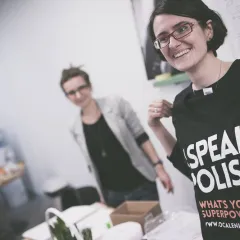As October is a month of saving, March is a month of women. Women’s day has been celebrated around the world for the last century in many different ways. It was first implemented by working class women, and for decades it was associated in Poland with a caricature of equality and a mandatory collection of tights, withered carnation and kissing women’s hands. Since 1990s the day has been taken over by a women’s movement and it’s been symbolised by demonstrations in many different Polish cities. Protestors have been focusing on particular slogans and this year 2011, it is: “No more exploitation – we won’t serve anymore.” Demonstrations have always been sparking discussions around women’s roles and responsibilities, as well as risks of emancipation and advantages of equality. Looking at the pre-war Jewish press we can notice similar debates. In “Nasz Przegląd” (March 1925) we can read about the immorality of Jewish women and suggestions of how to deal with the problem. This daily newspaper was one of the most influential journals of Jews living in Warsaw. It was published in Polish and aimed at Jews sympathizing with the Zionist movement. Usually it didn’t contain many articles about women, if any, they were mainly focusing on clothing or makeup, sometimes reporting on international Zionist women meetings or pioneer women work in Palestinian colonies. One day an author with initials S.H started a discussion about women’s role in a Jewish society. The debate lasted a few weeks and it was initiated by his/her statement that: “In all national catastrophes experienced by Jewish people (even when we take into consideration many reasons that happened regardless of our actions and situations when we cannot see a clear reason for certain things) one can find a theme of “cherchez la femme” (from French; look for a woman!). S.H cites an article taken from a Viennese newspaper: “A woman who has no idea about anything and doesn’t want to change it, becomes a major problem especially for a Jewish community. A woman who doesn’t know anything is like a disease which has attacked our body and spread among the whole Jewish middle class. A husband became like a machine providing for his family, earning and bringing money to his wife who has no idea about anything, and to his children who don’t want to know anything”. S.H emphasises that this statement also relates to the Polish Jewish women.
This sudden attack on Jewish women took place at the time when a growing number of Jews who were trying to assimilate with other nationalities experienced a financial crisis. On one hand, women were accused of indifference towards cultural and political matters of a Jewish minority, which caused lack of a strong national identity in their children. On the other hand, ladies were greedy for shiny jewellery which supposedly caused a crash of the financial market, and the failure of the men who worked like horses trying to pander their women’s whims. In response to those accusations the readers of “Nasz Przegląd” react in many different ways. R. Szteiner admits that women in those times weren’t ready to do their duties but she takes other countries as examples to emphasises something else. “Western democracies and all socialists understood a long time ago that social and political awareness of the mass of women is crucial. They knew that it was impossible to have perfect family relations, rational children’s upbringing or a successful struggle over social justice, as long as the mass of women represented low levels of culture and had no understanding of noble duties and aims. Among the tasks pursued by socialists in order to change the law, were: liberating the mass of women from the influence of the clergy and opinions of other people, involving them in the social whirl, giving them all possible job opportunities and making their right to work equal to that of men (source text). Szteiner’s opinion (radical in comparison to others) was one of a few that drew attention to the need of equality and emancipation of women. The biggest part of the discussion in question evolved around finding somebody to blame. A reader named Borys Cymberg “defends” women saying: “Man, by trying to satisfy his violent desire, created woman who is willing to do anything in order to get some shiny jewellery. (...). Our desire for an easy prey created a woman who is like a doll. (...) Since we created such a woman we have to accept the consequences”. In his opinion, women willingly allowed men to shape them, therefore only men can change the situation. His view is contradicted by Adolfowa Raciążek who argues that: “For centuries women have been striving for a certain type of perfection. Having spared no efforts (often futile) they were attempting to be as they should be, and not as they were “wanted” by proud and selfish men. The concept itself offends women. (...) Why do we never tell men to be the way as they are “wanted” by women?”
Freda Liwerowa, for a change, estimates men’s expenses for cabarets and elegant clothes, proving that it’s not women who are responsible for problems with domestic budgets. Other people point out poor education for girls (responsible for their immoral behaviour) and blame men for not talking to their wives about their businesses, which makes women unaware of economic and financial matters. The discussion continued throughout March 1925 (next to subjects like political situation in Germany and soap commercials). At the end, a reader M.H asked everyone to reconcile with each other saying: “It’s not only women who are to be blamed. Therefore we should demand unconditional solidarity from our husbands and sons. Those who are our prosecutors should think about their own guilt first. (...) That is why we should stop blaming each other and try to work all together for our holly case.”
Nowadays, when I read lofty, sometimes grotesque-like opinions, I think that “we know this already”. Maybe in a different form but now, ninety years later, the issue still remains the same.
Katarzyna Czerwonogóra
Translated by: Anna Martinsen









